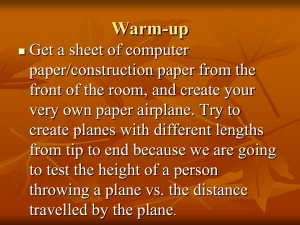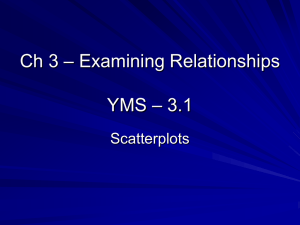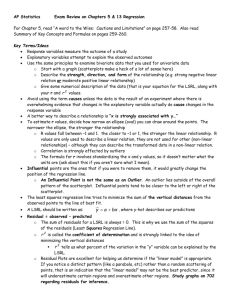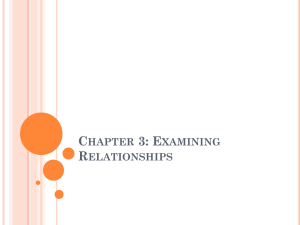Chapter 3 Section 2 Powerpoint Notes
advertisement
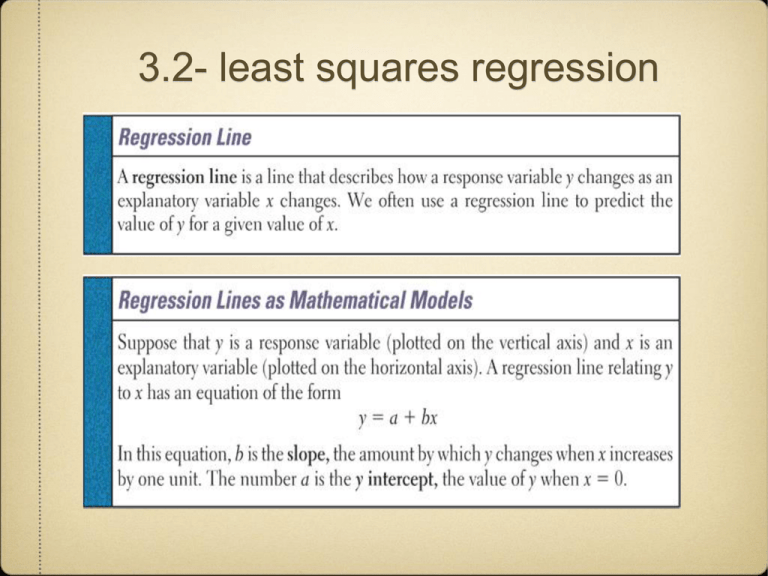
3.2- least squares regression 3.2- least squares regression The slope here B = .00344 tells us that fat gained goes down by .00344 kg for each added calorie of NEA according to this linear model. Our regression equation is the predicted RATE OF CHANGE in the response y as the explanatory variable x changes. The Y intercept a = 3.505kg is the fat gain estimated by this model if NEA does not change when a person overeats. Prediction • We can use a regression line to predict the response y for a specific value of the explanatory variable x. LSRL • In most cases, no line will pass exactly through all the points in a scatter plot and different people will draw different regression lines by eye. • Because we use the line to predict y from x, the prediction errors we make are errors in y, the vertical direction in the scatter plot • A good regression line makes the vertical distances of the points from the line as small as possible • Error: Observed response - predicted response LSRL Cont. Equation of LSRL • Example 3.36: The Sanchez household is about to install solar panels to reduce the cost of heating their house. In order to know how much the panels help, they record their consumption of natural gas before the panels are installed. Gas consumption is higher in cold weather, so the relationship between outside temp and gas consumption is important. LSRL Equation yˆ a bx a = the intercept of the line a y bx Fact!: Every LSRL line passes through b = the slope of the line br sy sx x , y Dinosaur Bones Archeologists want to determine if a new bone belongs to a certain species of dinosaur. They have a set of bones that they KNOW go together and have recorded the Femur lengths and Humerus lengths. Analyze the data and determine if there is a relationship. FEMUR 38 56 59 64 74 HUMERUS 41 63 70 72 84 Create a scatterplot Analyze the scatterplot Find the correlation Find the LSRL Interpret Describe the direction, form, and strength of the relationship • • About how much gas does the regression line predict that the family will use in a month that averages 20 degreedays per day? • • Positive, linear, and very strong 500 cubic feet per day How well does the least-squares line fit the data? Residuals • The error of our predictions, or vertical distance from predicted Y to observed Y, are called residuals because they are “left-over” variation in the response. Residuals One subject’s NEA rose by 135 calories. That subject gained 2.7 KG of fat. The predicted gain for 135 calories is Y hat = 3.505- .00344(135) = 3.04 kg The residual for this subject is y - yhat = 2.7 - 3.04 = -.34 kg Residual Plot • The sum of the least-squares residuals is always zero. • The mean of the residuals is always zero, the horizontal line at zero in the figure helps orient us. This “residual = 0” line corresponds to the regression line Residuals List on Calc • If you want to get all your residuals listed in L3 highlight L3 (the name of the list, on the top) and go to 2nd- stat- RESID then hit enter and enter and the list that pops out is your resid for each individual in the corresponding L1 and L2. (if you were to create a normal scatter plot using this list as your y list, so x list: L1 and Y list L3 you would get the exact same thing as if you did a residual plot defining x list as L1 and Y list as RESID as we had been doing). Examining Residual Plot • Residual plot should show no obvious pattern. A curved pattern shows that the relationship is not linear and a straight line may not be the best model. • Residuals should be relatively small in size. A regression line in a model that fits the data well should come close” to most of the points. • A commonly used measure of this is the standard deviation of the residuals, given by: residuals s 2 n2 For the NEA and fat gain data, S = 7 .6 6 3 14 .7 40 Residual Plot on Calc • Produce Scatterplot and Regression line from data (lets use BAC if still in there) • Turn all plots off • Create new scatterplot with X list as your explanatory variable and Y list as residuals (2nd stat, resid) • Zoom Stat R squared- Coefficient of determination R squared- Coefficient of determination If all the points fall directly on the least-squares line, r squared = 1. Then all the variation in y is explained by the linear relationship with x. So, if r squared = .606, that means that 61% of the variation in y among individual subjects is due to the influence of the other variable. The other 39% is “not explained”. r squared is a measure of how successful the regression was in explaining the response Facts about LeastSquares regression • The distinction between explanatory and response variables is essential in regression. If we reverse the roles, we get a different least-squares regression line. • There is a close connection between corelation and the slope of the LSRL. Slope is r times Sy/Sx. This says that a change of one standard deviation in x corresponds to a change of 4 standard deviations in y. When the variables are perfectly correlated (4 = +/- 1), the change in the predicted response y hat is the same (in standard deviation units) as the change in x. • The LSRL will always pass through the point (X bar, Y Bar) • r squared is the fraction of variation in values of y explained by the x variable



